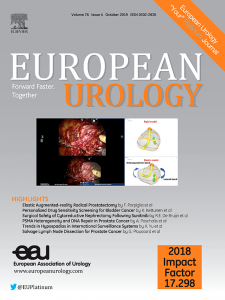转移性肾细胞癌的一线和二线疗法
IF 25.3
1区 医学
Q1 UROLOGY & NEPHROLOGY
引用次数: 0
摘要
背景和目的近年来,转移性肾细胞癌(mRCC)的治疗格局发生了显著变化,从而改善了治疗效果。本综述旨在为临床医生提供实用指南,帮助他们在现有证据的基础上选择一线和二线治疗方法。我们在PubMed和Embase上进行了全面的文献检索,并手动检索了截至2024年10月的指南和会议论文集。主要发现和局限性一线治疗方案包括基于免疫检查点抑制剂(ICI)的联合疗法或酪氨酸激酶抑制剂(TKIs)。国际上已批准了四种联合疗法。由于缺乏头对头试验和标准化生物标志物,治疗决定取决于国际转移性 RCC 数据库联盟 (IMDC) 的风险评分、功能状态、安全性概况、肉瘤特征、免疫抑制剂的使用以及是否需要立即治疗等因素。尽管取得了进步,但许多患者在接受基于 ICI 的治疗后仍会出现疾病进展,需要进一步治疗。对标准化二线治疗方法的需求仍未得到满足。TKIs(单独使用或与依维莫司联合使用)显示出良好的疗效,而HIF2a抑制剂则提供了毒性较低的新选择。结论和临床意义为优化 mRCC 治疗选择,临床医生必须仔细权衡疗效、毒性和患者偏好,尤其是在一线和二线疗法之间转换时,以提供个体化治疗。本文章由计算机程序翻译,如有差异,请以英文原文为准。
First and Second-line Treatments in Metastatic Renal Cell Carcinoma
Background and objective
The treatment landscape for metastatic renal cell carcinoma (mRCC) has evolved significantly in recent years, leading to improved outcomes. The aim of this review is to provide clinicians with a practical guide for selecting first- and second-line treatments on the basis of current evidence.
Methods
We critically evaluated systemic treatment strategies for mRCC. A comprehensive literature search was conducted in PubMed and Embase, alongside manual searches of guidelines and conference proceedings up to October 2024. A narrative review was performed to reach a consensus, with voting used to resolve differing opinions among authors.
Key findings and limitations
First-line treatment options include immune checkpoint inhibitor (ICI)-based combinations or tyrosine kinase inhibitors (TKIs). Four combination regimens have been approved internationally. Owing to the lack of head-to-head trials and standardized biomarkers, treatment decisions rely on factors such as International Metastatic RCC Database Consortium (IMDC) risk score, functional status, safety profiles, sarcomatoid features, use of immunosuppressive drugs, and need for immediate response. Despite advances, many patients will experience disease progression on ICI-based therapy, necessitating further treatment. The need for standardized second-line approaches remains unmet. TKIs, alone or with everolimus, show promising efficacy, while HIF2a inhibitors offer newer options with a favorable toxicity profile. Rechallenge with ICIs after early progression is not recommended.
Conclusions and clinical implications
For optimal mRCC treatment selection, clinicians must carefully balance efficacy, toxicity, and patient preferences, especially when transitioning between first- and second-line therapies, to provide individualized care.
求助全文
通过发布文献求助,成功后即可免费获取论文全文。
去求助
来源期刊

European urology
医学-泌尿学与肾脏学
CiteScore
43.00
自引率
2.60%
发文量
1753
审稿时长
23 days
期刊介绍:
European Urology is a peer-reviewed journal that publishes original articles and reviews on a broad spectrum of urological issues. Covering topics such as oncology, impotence, infertility, pediatrics, lithiasis and endourology, the journal also highlights recent advances in techniques, instrumentation, surgery, and pediatric urology. This comprehensive approach provides readers with an in-depth guide to international developments in urology.
 求助内容:
求助内容: 应助结果提醒方式:
应助结果提醒方式:


